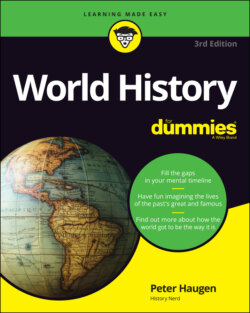Читать книгу World History For Dummies - Peter Haugen - Страница 35
Putting History into Perspective
ОглавлениеIN THIS CHAPTER
Seeing through the long lens of humanity’s time on Earth
Figuring out BC and AD
Accepting the relativity of the names of eras
Embracing contradictory characters
In several places in this book, I refer to the year 1492, when the explorer Christopher Columbus, sailing under a Spanish flag, landed for the first time on an island in the Bahamas, east of Florida. That year is a big dividing point in history, in that it marks the beginning of European colonialism in the Americas. The Western Hemisphere changed in ways that were devastatingly tragic for the people who had been living there. Diseases from Europe killed them by the millions. The rest of the world, meanwhile, saw changes that ranged from new crops (corn, potatoes, tobacco, peppers, coffee) to population migrations, to new, lucrative markets for slave trading (the most pernicious kind of population migration). A global economy took root once European navigators realized they could sail to new worlds, and soon around the world, in their little wooden ships.
Yet according to The New York Times, a survey conducted back in 2008 showed that fewer than half of teenagers in the United States could correctly pick the date of Columbus’s discovery from a multiple-choice list. If today’s teenagers, or adults, were given the same test, how many would choose the right answer? Many people have trouble putting history and its events into perspective. The history of the world is such a huge topic, covering so many eras, cultures, events, conflicts, ideas, and beliefs, that it’s easy to get mixed up. Three common problems that you may have are:
Sorting out such terms as ancient, recent, and modern when they’re used by historians and other scholars and connecting them with the stretches of time that people have lived on the planet.
Getting comfortable with labels such as classical and Victorian that historians use to refer to eras and periods. Often, these labels can seem more cryptic than helpful.
Understanding the often-contradictory reasons why certain exceptional people are judged to be worthy of historical study.
In all three cases, I suggest that you relax. The terminology is less important than you may think.
In this chapter, you get a chance to ponder what it means to be human before you plunge into the cavalcade of civilizations that follows in Part 2. If you can work up a healthy sense of awe about our remarkable species and its beginnings, you’ll be better able to appreciate the broad sweep of time that people have been around. And you can see that historical language — including relative terms such as ancient and labels for eras such as Classical Greece — is somewhat flexible and may be used differently by different historians. As with any subject matter, there are different ways of looking at history and even different ways of evaluating people in history. Sometimes perspectives conflict, but they can also complement one another.
